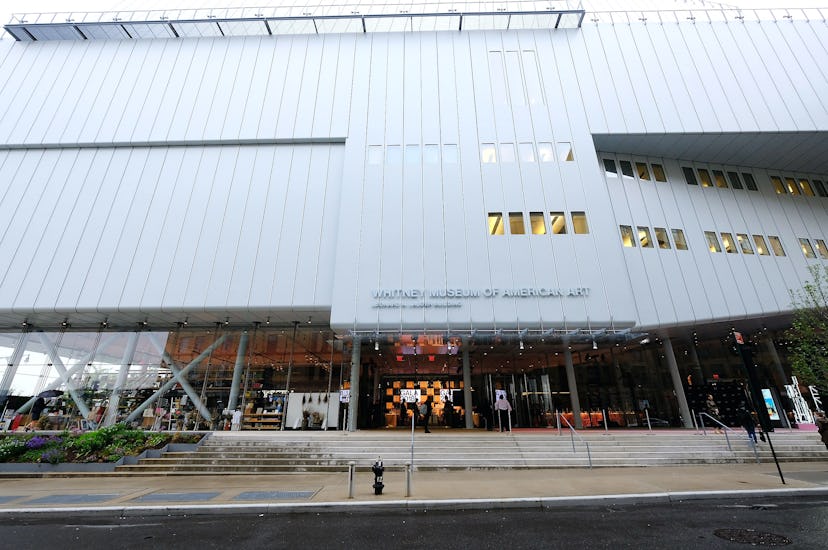The Whitney Museum’s Latest Controversy Might Be Its Messiest Yet
The museum has cancelled an exhibit of new acquisitions, which were actually donations to Black communities and COVID-19 relief.

Around 9 p.m. on Monday, about 80 artists were suddenly notified that the Whitney Museum of American Art had acquired one of their works. Normally, the news would be cause for celebration—even a career milestone—with inclusion in an upcoming show at the premier exhibition space for contemporary American artists the cherry on top. But to those who quickly shared the news on social media, the out-of-the-blue email came as an unwelcome shock.
“Your level of entitlement and colonial mentality is THROUGH THE FUCKING ROOF,” the photographer Dana Scruggs posted on Instagram, tagging the Whitney and the exhibition’s curator, Farris Wahbeh. “Just because y’all have historically and intentionally excluded us from The Whitney doesn’t mean we’ll be on our knees thanking you for letting us in the main house.”
The email’s tone was congratulatory, but it conveniently glossed over the fact that each work only cost the Whitney around $100—a fraction of the usual market price. The money would not be going to Scruggs, whose prints typically sell for thousands, nor any of the other artists, because they were never intended for personal profit. The works in question were actually donations, meant to generate money for Black communities and COVID-19 relief while also opening up the accessibility of the works to normal people. In exchange, the artists would only receive a lifetime pass for free museum entry. While the exhibition would presumably feature more than those prints, at no point, apparently, did the organizers think to get these artists’ consent.
A screenshot of Farris Wahbeh’s announcement of “Collective Actions: Artist Interventions In a Time of Change,” taken on Tuesday afternoon.
News of the exhibition, “Collective Actions: Artist Interventions In a Time of Change,” had actually been out for a full week. Though the artists who had their worked acquired through charity print sales only learned as much when they visited the curator’s Instagram, and found a post that left out key details like all but one of the artists’ names. It was their first opportunity to respond, and many seized it. So did their supporters, some of whom kept it simple: “Y’all really out here #looting huh,” wrote the artist and curator Pastiche Lumumba. None of the 130-plus comments remain visible to the public: Wahbeh made his account private, just in time for the Whitney’s official announcement that the exhibition had been canceled.
By then, it was already too late. Critics had banded together, like those behind one of the show’s chief sources: a sale organized by See in Black, benefiting the Bail Project and the National Black Justice Coalition. “It has always been our objective to promote ownership, autonomy, and respect for Black creatives in an effort to shift the current paradigm upheld by white supremacy,” the collective said in a statement. “The Whitney’s use of the works acquired through the See in Black print sale at significantly discounted prices—the proceeds of which were donated 100% to charity—constitutes unauthorized use of the works to which the artists do not consent.”
Meanwhile, in New York, “Whitney Museum” started trending on Twitter. “It’s the audacity of @whitneymuseum for me,” the photographer Quil Lemons wrote. “I don’t think y’all understand how blatantly disrespectful this is.” The photographer Gioncarlo Valentine shared his discovery that Wahbeh had been following him, though to his knowledge had never engaged with his work.
That the Whitney should know better by now only added insult to injury. The museum is still dealing with the consequences of one of its most recent controversies—which is to say it may soon be under investigation by the IRS. (A former federal prosecutor filed a complaint following the months-long protests over its now former vice chairman, the CEO of weapons manufacturer Safariland.) In 2017, the controversy over the Whitney Biennal’s inclusion of a Dana Schutz painting of the lifeless, mangled Emmett Till lasted for nearly five months.
Around 3 p.m. on Tuesday, the 80 or so artists in question received another email—this time, informing them that their works wouldn’t be going on display after all. Wahbeh also apologized, and clarified that he’d collected their works as part of the Whitney Special Collections, “an area that houses artists books, zines, posters, prints, and objects that document how artists distribute published materials as a form of practice…and are collected as the materials are launched and circulated.” Going forward, Wahbeh promised, the museum will reconsider its approach to doing what he had intended: “build[ing] on a historical record of how artists directly engage the important issues of their time.”
But to Scruggs, that’s not enough. “Canceling the exhibition rather than PAYING BLACK ARTISTS FOR THEIR WORK is exactly what we would expect of an institution that has actively denied Black Artists and Curators space within its halls since it’s inception,” she wrote in response. In an interview with the New York Times, she offered a solution: “Instead of canceling, they should actually pay us for the full price of our work and hold the exhibition instead of cowering in the face of everyone calling them out.”
As for the long term, a popular suggestion has been to diversify senior management at the Whitney. It’s hardly the only institution needing to do so, but to many, the Whitney’s shortcomings stand apart. “The Whitney is by far the most transparently racist and corrupt museum in New York, and there’s A LOT of competition in that field,” the artist Anthony Santulli tweeted at the museum. “I want an honest answer: how many times do you need to be called out for this kind of thing before you actually make a change?”
Related: Here’s One Way to Deal with Problematic Artworks, Like Sam Durant’s Scaffold: Burn Them